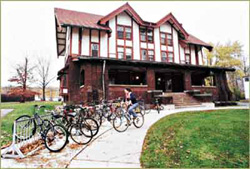

|
|
Keep
Cottage continues a tradition of self-boarding
that began over a century ago.
Earning their
keep
|
||
|
||
|
A
legacy has taken root at Keep Cottage, a legacy of cooperative
living. The Oberlin Student Cooperative Association celebrates the
50th anniversary of campus cooperatives this year. Among OSCA's
buildings, Keep has been a cooperative the longest, gaining that
status in 1965. Two earlier co-ops--Pyle Inn and Grey Gables--have
since been razed. by GAIL TAILOR |
